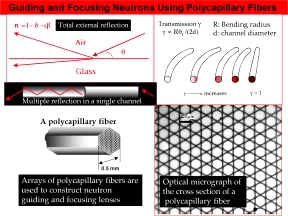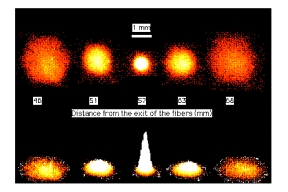NEUTRON FOCUSING WITH CAPILLARY OPTICS
It is very difficult to focus neutrons, because they are chargeless particles
which interact only weakly with matter. An efficient neutron lens is a
device which has long been desired, but, until recently, no viable concept
existed for such a device. In the past few years, the situation has changed.
Microcapillary optics have been developed which can be used to focus both
X-rays and neutrons. This has been made possible through the fabrication
of glass fibers in which an array of microscopic channels are imbedded,
each channel a few microns in diameter, and all channels perfectly parallel
within each glass fiber. A bundle of such glass fibers make up a neutron
lens, if all the exiting ends of the fibers can be pointed towards a common
focus. The fibers must be very gently and accurately bent, so that neutrons
can undergo multiple reflections along the interior surfaces of the channels,
all the while maintaining an angle of incidence on each bounce which is
less than the critical angle for total reflection, typically a fraction
of a degree.
The technology of the glass fiber fabrication originates from the former
Soviet Union. NIST scientists, in collaboration with scientists and engineers
from Russia and a small U.S.company, are doing the basic science underpinning
the development of a viable neutron lens. The lens device is placed in
a cold neutron beam at the NCNR, and the image of the
focused neutrons is recorded along the exit path by means of a neutron
area detector, and a video recording system.
 |
 |
Schematic depiction of the neutron focusing principle and capillary
fibers used.
|
Output of the neutron video recording device. A flux gain of a factor
of 80 at the spot, compared with the original beam, and a spot size of
less than a millimeter, have been achieved. |
Contacts:
David Mildner, (301)975-6366,
david.mildner@nist.gov
Heather Chen, (301)975-3782,
heather.chen-mayer@nist.gov
-
Project Goals
To produce intensified neutron flux on a small sample area.
-
Initial Applications Improved spatial resolution and lowered detection
limits for neutron-based analytical methods, such as Cold
Neutron Depth Profiling (CNDP) and Prompt
Gamma Activation Analysis (PGAA).
-
Technique Using polycapillary glass fibers as small neutron guides,
a neutron lens can be made. The neutron optical properties of both individual
fibers and of prototype lenses are being studied.
Last modified 14-August-2012 by website owner: NCNR (attn: )
|

